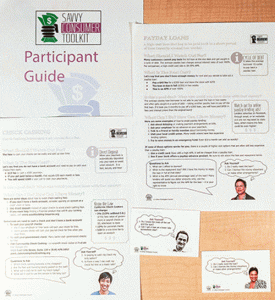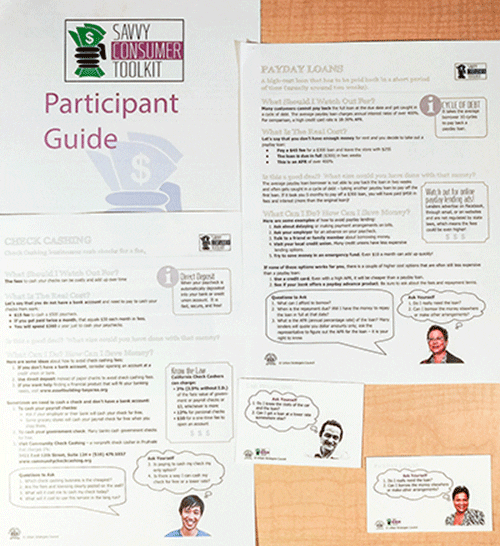
A large part of my work as a financial services coordinator was to develop and present financial capability classes to youth and young adults. While I believe we all should learn how to establish and build credit, understand compound interest, and learn about the different financial products available to us, I was increasingly frustrated by the laser-like focus in most curricula on an individual’s financial choices. The focus seems to imply that low-income individuals are at fault if they are struggling financially because they have made bad choices, or because they lack the discipline to improve their financial condition.
By teaching the benefits and drawbacks of personal financial decisions, we are ignoring the larger financial context in which individuals makes their decisions. This was really brought home to me as I taught financial capability to a group of soon-to-be eighth-graders in a middle school summer program. Together we worked to set financial goals and develop savings plans that were realistic for each student’s current financial situation. I suggested some possible long-term goals, like saving some money toward college expenses, buying a used car, or taking a trip out of the country. One of the eight young men in the class laughed and said, “This teacher thinks that we can do any of these things!”
At first, I was stunned. But after thinking about it, I realized that he grew up in an environment where no one goes to college, few people have cars, and if families go on vacation, they certainly don’t get on planes and go to other countries. He didn’t see any of my suggestions as possibilities for himself, because he did not see anyone around him doing those things.
This speaks to the limited possibilities present in many low-income neighborhoods. I was encouraging the students to set long-term goals and create plans for how they could save a small amount each month to eventually reach their goal—a common aspect of financial capability classes and financial coaching programs. The student told me that this didn’t fit the reality of what he saw every day. He saw people who struggled to save small amounts of money, only to frequently spend their savings on penalties and charges like check cashing, overdraft, and late fees. While different families make different financial choices, they all experience similar systemic challenges—underperforming schools, soaring rents, violence, and a contracting economy in which they have the double disadvantage of limited work experience and few if any connections in the professional world. One unexpected situation can throw a family into crisis because they have no savings to rely on and their extended family is not able to help financially. In this context, sometimes going to a payday lender, for example, might be the only logical choice available.
A Different Way
I now manage the Alameda County Community Asset Network, which was founded and is staffed by the Urban Strategies Council in Oakland. AC CAN is a working group of over 40 service providers, credit unions, community-based organizations, public agencies, and base-building groups that work in partnership to create economic equity in Alameda County. The network brings people together to explore topics related to income and asset building, creates a learning and referral community among its member organizations, and develops innovative asset-building strategies.
I first learned about one such strategy, the Savvy Consumer Toolkit, when I was in direct service work, and I had the opportunity to use the toolkit with some of my clients. I found it appealing because it addressed individual choices and it was grounded in an analysis of the systems that target and take advantage of consumers in low-income communities. The Savvy Consumer Toolkit builds on community experience to raise awareness and develop critical thinking skills about predatory products and low-cost alternatives. It speaks to low-income families who are “underbanked” and connects them to lower-cost alternative products to build and preserve wealth. The toolkit was designed to help consumers make smart choices with their money, while also non-judgmentally acknowledging the real need to sometimes use what could be a predatory product. It does this through focusing on the ability to know the potential consequences of each product so that the individual can make an informed choice.
The curriculum includes one-pagers on a variety of potentially predatory financial products, such as car title loans, tax refund anticipation loans, check-cashing services, and payday loans. Each page explores questions such as, “What should I watch out for?” and “What is the real cost?” and suggests alternative products or strategies so the consumer can make an informed decision. Wallet cards on the same topics provide questions to ask at the point of sale to help consumers get all of the information about the product and the hidden fees that may be charged later.
The toolkit also includes a module that prompts participants to examine the predatory nature of some financial products, and how they tend to be clustered in low-income communities and communities of color. When I facilitated the Savvy Consumer Training, participants quickly identified that they were targeted for high-interest products like payday loans while they did not have easy access to lower-interest products such as personal loans or credit cards. They connected their immediate conditions to systemic issues and were understandably angry because their community was being preyed upon.
The Savvy Consumer Training concludes by inviting participants to choose ways in which they want to take action to address the systemic inequalities they are experiencing. These can range from using training materials to ask questions when considering the use of predatory financial products, to telling friends and family about the ways that low-income and communities of color are being targeted by predatory financial products. Participants are also encouraged to take action outside of their own community by reporting complaints about a particular financial service to the Consumer Financial Protection Bureau, a government agency that regulates banks, lenders, and other financial companies. Participants can also get involved with an advocacy campaign that works to tighten regulation of potentially predatory products. Participants in the training I facilitated felt empowered through acknowledging the larger system that is targeting them.
There is still work to be done in the field of income and asset development, and we must reflect on our work to make sure we are not only equipping individuals with the knowledge to make informed choices, but also empowering them to challenge the inequity and systemic barriers they face.






Financial resiliency (thriving), needs to be at the top of the agenda vs financial sustainability (surviving). It is important not to give up, both within the financial betterment realm AND the political participation process of voting for those, and those issues, that align with everyone thriving!